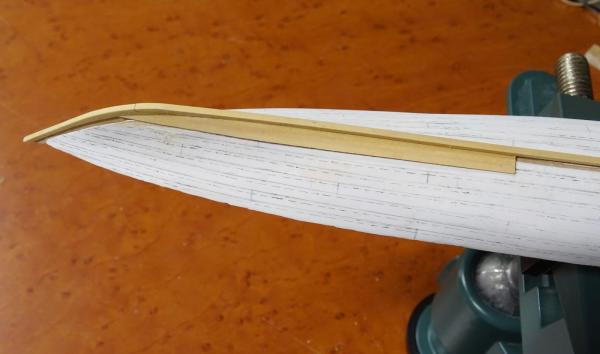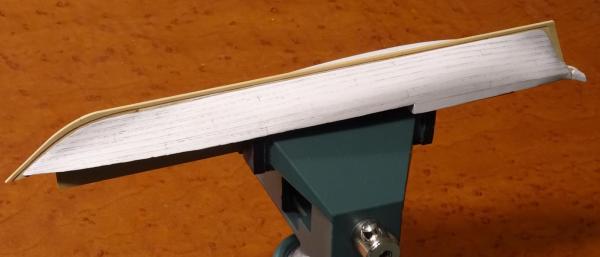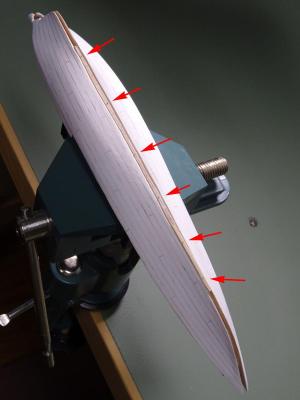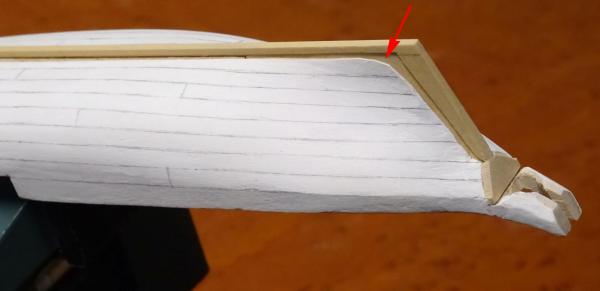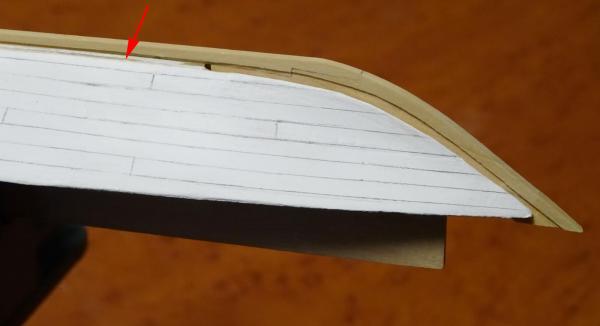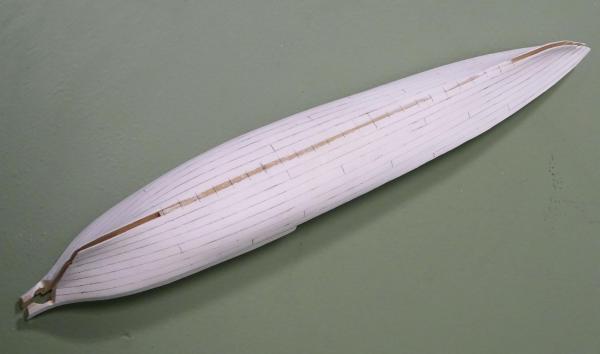-
Posts
13,300 -
Joined
-
Last visited
Content Type
Profiles
Forums
Gallery
Events
Everything posted by druxey
-
Thank you, gentlemen all. Finally had some quality time on the model. The first garboard plank is now spiled, cut, shaped and fitted. The stock is thin enough to cut with a sharp scalpel blade. The twist was achieved by cold wet bending and holding in place using rubber bands until dry. Castello takes more persuasion to bend than holly. Once the plank was dry, it was glued in place. I needed to cut back the plug more at the bow to allow the plank to land nicely in the bow rabbet. One plank down, many more to go!
- 641 replies
-
- greenwich hospital
- barge
-
(and 1 more)
Tagged with:
-
A two year old? What were they thinking???? Anyway, both models are a good restoration challenge and I'm looking forward to seeing them returned to their former glory. Good luck with them.
-

White Paint Issues
druxey replied to rynmss's topic in Painting, finishing and weathering products and techniques
And is the paint well stirred? In some paints the pigment tends to settle out fairly quickly. -
Thanks for all the 'likes' and comments, everyone. Dan: the planking butts are arranged to fall on the frames in the model. I'm not going as far as bevelled and clenched joints on 1/64" thick material! This is a 1:48 scale exercise. I may be mad, but not entirely crazy.
- 641 replies
-
- greenwich hospital
- barge
-
(and 1 more)
Tagged with:
-
That's correct, Joel - I hope! The last clinker boat I built was done this way. It's amazing how clinker planking holds the boat's shape. I even took the boat off the plug when half-planked to demonstrate. The frames will be bent in later on in the process.
- 641 replies
-
- greenwich hospital
- barge
-
(and 1 more)
Tagged with:
-
After the full model, you should be able to do the deck framing in your sleep, Dan! Looking good.
- 268 replies
-
Yes, I agree - what you've done is akin to watchmaking! Well played, Ed.
- 3,618 replies
-
- young america
- clipper
-
(and 1 more)
Tagged with:
-
Looking good, but has the fore end of the coaming come adrift?
- 258 replies
-
- buzzards bay
- herreshoff
-
(and 1 more)
Tagged with:
-
A small update: Before waxing the plug, I drew in the overlaps of the clinker planking. I made them 1" wide and are seen as dashed lines on the plug. Two coats of Clapham's beeswax polish were used over the mark-out. Leaves of ¾" thick Castello have now been prepared for the planking. They were cut a little over-thick and then taken down almost to spec on a thickness sander. Finer grades of sandpaper on sanding blocks produced a smooth surface. Hopefully there will be time to commence planking soon.
- 641 replies
-
- greenwich hospital
- barge
-
(and 1 more)
Tagged with:
-

ancre Le Fleuron 1729 by rekon54 - 1:24
druxey replied to rekon54's topic in - Build logs for subjects built 1501 - 1750
Lovely details! -
Quite the forest of ventilators!
- 2,625 replies
-
- kaiser wilhelm der grosse
- passenger steamer
-
(and 1 more)
Tagged with:
-

Echo by Maury S - FINISHED - Cross-Section
druxey replied to Maury S's topic in - Build logs for subjects built 1751 - 1800
That's a different kind of display case and works wonderfully. Well done, Maury.- 324 replies
-
Well, there's been a little progress made between other projects. I decided to revise the scheme of planking butts and I'm happier with the new layout. The plug has been cut back along the central spine (arrowed) to ensure that it will not become accidentally glued to the plug while planking. The tiny transom has also been added and bevelled to conform to the plug's contours. The overall photo shows six small brass pins in place to secure the keel while installing the garboard strakes. Next up will be to wax the plug, then cut some very thin planking stock to ¾" thickness.
- 641 replies
-
- greenwich hospital
- barge
-
(and 1 more)
Tagged with:
-
Like Michael, I've followed your work over many years, after stumbling across pictures of your tulipwood Hispano Suiza and one of your books. Thank you for sharing this project with us.
- 281 replies
-
- falls of clyde
- tanker
-
(and 2 more)
Tagged with:
-
After some re-working of the planking runs, I've devised a scheme for the shift of the butts and marked these on the plug. Now that the 'non-boat' work is almost complete, it's time to get back to the actual model. I needed to devise a method of keeping the keel straight on the plug. If not stabilized, it will deflect as I fit the garboard strake. My solution is to drill small holes at intervals along the plug, then set sharp-ended pieces of hard brass wire, points uppermost. The keel will be pressed down onto these points. The resulting holes will be hidden under the keelson later on.
- 641 replies
-
- greenwich hospital
- barge
-
(and 1 more)
Tagged with:
-
Ah! Another Saturday 'fix' - I mean update on your exquisite work for us to enjoy. Thanks, Glenn.
-

Cutter Cheerful 1806 by rafine - FINISHED
druxey replied to rafine's topic in - Build logs for subjects built 1801 - 1850
Very nicely accomplished Bob.Well done!- 525 replies
-
- cheerful
- Syren Ship Model Company
-
(and 1 more)
Tagged with:
-
Interesting comparisons, Jerry. But here's a counter-argument to consider: Say you build your model from maple and the outlay is $40.00 (I figure that there will be quite a few 'makeover' bits, so two boards). Pear might cost twice as much. A Bonnehomme Richard model will probably take you 2000 hours to build. Amortize this in cents/hour. That's about 2c for the maple and 4c for pear. Pear or another specie of wood isn't such a huge investment when looked at that way, especially when you invest so much of your time and skill.
-
Lovely miniature metalwork, Ed. The third hands and rotating ceramic plate are a nice sophistication over earlier fixed base soldering stations.
- 3,618 replies
-
- young america
- clipper
-
(and 1 more)
Tagged with:
-
Thanks, Siggi. The barge is displayed much better than it used to be years ago. Fortunately the Greenwich Hospital barge has nowhere nearly as much carved work!
- 641 replies
-
- greenwich hospital
- barge
-
(and 1 more)
Tagged with:
About us
Modelshipworld - Advancing Ship Modeling through Research
SSL Secured
Your security is important for us so this Website is SSL-Secured
NRG Mailing Address
Nautical Research Guild
237 South Lincoln Street
Westmont IL, 60559-1917
Model Ship World ® and the MSW logo are Registered Trademarks, and belong to the Nautical Research Guild (United States Patent and Trademark Office: No. 6,929,264 & No. 6,929,274, registered Dec. 20, 2022)
Helpful Links
About the NRG
If you enjoy building ship models that are historically accurate as well as beautiful, then The Nautical Research Guild (NRG) is just right for you.
The Guild is a non-profit educational organization whose mission is to “Advance Ship Modeling Through Research”. We provide support to our members in their efforts to raise the quality of their model ships.
The Nautical Research Guild has published our world-renowned quarterly magazine, The Nautical Research Journal, since 1955. The pages of the Journal are full of articles by accomplished ship modelers who show you how they create those exquisite details on their models, and by maritime historians who show you the correct details to build. The Journal is available in both print and digital editions. Go to the NRG web site (www.thenrg.org) to download a complimentary digital copy of the Journal. The NRG also publishes plan sets, books and compilations of back issues of the Journal and the former Ships in Scale and Model Ship Builder magazines.



